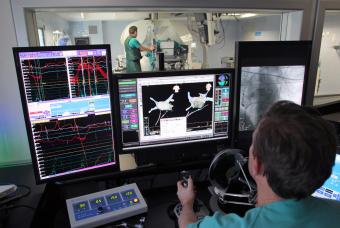Operating on the Heart with a 'Joystick'
March 08, 2011
Translation from original Spanish article on ElPais.com
The doctor is comfortably seated, and the patient, about six feet away, sleeps or watches TV. If it weren’t for the gowns covered with lead shields to avoid radiation and the abundance of screens, no one would say that what is happening is that the physician is moving a catheter through the right atrium of the patient’s heart. It is a demonstration of the CGCI in the Robotic Cardiac Electrophysiology Unit of the La Paz Hospital in Madrid.
José Luis Merino, the cardiologist, displays the image of the patient's heart on a screen. "The man has atrial fibrillation. They have tried to treat it twice at another hospital, and have not been able to." With a couple of controls (a joystick similar to those from computer games and another circular one that is a bit more complex) the doctor steers the catheter through the heart. For this, the device is responsible for translating the movement of the joystick (forward, backward, up, down) to eight electromagnets that regulate its power to steer the tip of the catheter within the organ.

Sensors used to find the point where the arrhythmia originates are at the end of a fine wire. Because even though we all have the idea that the heart is like an engine, it is not made up of rigid blocks. It is made of millions of muscle fibers that respond to electrical micro-stimulators (the ones that a pacemaker artificially reproduces, for example). And fibrillations happen when one point of the entire mesh gets out of alignment, dragging everything down with it. The probe measures the potential ones in order to identify the origin of the fibrillations.
"At the moment we only have authorization to use it to locate the source of the problem," Merino admits. This means that once the site has been located, a traditional procedure must be used for the second part of the process: cauterizing that area to eliminate interference. "The FDA (U.S. Drug Agency) has not yet approved it, but in future a similar catheter will be used in conjunction with CGCI to cauterize the chosen spot," Merino assures.
The process has several advantages. The first being accuracy. With current devices, which are introduced from the groin and managed from the outside, there are movements that the catheter isn’t capable of. "Take a look at this turn. This movement cannot be done with a conventional catheter," says the doctor as the catheter moves over areas between the left atrium and its ventricle, where there is an anomaly in the physio-electric properties of the heart wall. Furthermore, once the places where action has to be taken have been located, the system remembers them. You can go back to them at any time without having to repeat the search. The process, which can last from three to five hours, is much more comfortable: the doctor is seated, "and fatigue increases the risk of inaccuracy," he says.
There are other advantages: in the current procedure, the physicians need to use rays to know where the catheter is at all times. "With this system, we save on radiation for both the patient and us," Merino affirms. And, he doesn’t hide another aspect that he likes: "I control everything from here."
At the moment, the device in La Paz is the only one in the world. The hospital got it for free from the manufacturer, Magnetecs, because it is being tested. But this will allow them to double, Merino calculates, the number of procedures they perform per year (about 300 currently).
And, as it’s being used, they will see if it contributes to other benefits, such as reduced recovery and hospitalization time, "which would be a huge saving," says a spokesman for the center. "The device is easy to handle, but since we are still learning we do not know if we are going to save time, but it is logical to think so," Merino affirms.
Patient satisfaction will also be interesting, (potentially, the more than 50,000 who suffer from acute myocardial infarction each year in Spain). But we didn’t want to wake up the patient that was in the room at that time of this article.
For Further Information, Contact:
Daniel Saks, SVP, Corporate Affairs
(310) 670-7700 |

